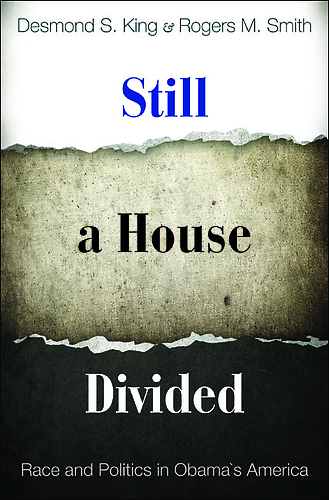On Friday, 11 November, 2011, Nuffield College hosted a panel of scholars in the field of American politics, identity, and race, to discuss the September 2011 publication of Still a House Divided: Race and Politics in Obama’s America by Desmond S. King and Rogers M. Smith.
The dialogue that ensued engaged the authors with a series of questions surrounding the book’s central thesis: despite the real progress in racial equality achieved by the 1960s civil rights legislation, the United States political institution has been caught in between two modes of conceptualizing, and enacting policy, about race— both of which have failed to close the tremendous gap in racial disparities in social and economic welfare that are a legacy of American history.
King and Smith characterize these two polarizing schools of thought as durable coalitions of political actors, social groups, and governing bodies, drawing on the civil rights messaging initiated by Martin Luther King, Junior and the 1964 Civil Rights Act. As with most binary oppositions in American politics today, these coalitions are neatly located within the ranks of the Republican and Democratic parties. The Colour-Blind Racial Alliance can be traced to 1978, when conservative attitudes agreed on a platform of denying the explicit consideration of race as a variable in forming policies to promote equal welfare. This brand of thinking contends that openly discussing the existence of racial prejudices, either held by individuals or embedded in institutions, is itself a form of racism. By contrast, the Race-Conscious Alliance, Smith and King suggest, also coalesced in the late 1970s, united behind the view that the recognition of existing and historical racial disparities must be central to the development of legislation aimed at correcting social injustices. Broadly supported by Democratic leaders, this manifesto is behind the policy of Affirmative Action.
With the re-election of Barack Obama now under scrutiny, the book comes at a pivotal time in the history of race politics in America. Dr. Mark Ledwidge, a critical race scholar and political scientist from the University of Canterbury, remarked at Friday’s event: “Obama’s presidency raised a lot of expectations [regarding] race in America. Would he be known as a ‘black’ president, or would he be recognized along with his predecessors as ‘simply another’ US president?”. As the Obama presidency has unfolded, it seems it has been a mixture of both; nevertheless, the fact that Obama did not run for election as a Black candidate (despite winning over 90% of the votes of the African American community) but rather ran a strategically race-neutral campaign is a testament to the complicated relationship the United States has with race. According to Dr. Ledwidge, the concept of “race neutrality” or “colour blindness” is “off the mark— what appears to be neutral is [actually] regressive and harmful because historical injustices have created such an unequal environment that initial material deficits [along racial lines] must be recognized before they are able to be dealt with.” He maintains “Economic issues are the hinge of current U.S. race relations.”

With the latest US Census Report confirming that poverty is at a 52-year high, with 27.4% of African Americans living below the poverty line, it is hard to disagree. The Census Bureau findings reaffirm a recent study published by the Pew Research Centre, demonstrating that the gap between the average black and average white households in 2009 widened to margins unparalleled since the 1980s, when median white household wealth was about $113,000, compared to about $5,700 for black families.
In approaching the research that formed the foundation for this book, Smith clearly had these figures in mind. He stated at the launch: “questions of economic inequality are central to race questions [and that] in the United States in particular, there is a racial dimension to redistribution.” King reiterated this point, offering his view on how “the current recession is only worsening the racial gap in income inequalities,” referencing the Pew Centre Study cited above. He calls for a new era of “racially-targeted policies” that directly respond to these patterns of structural injustice that are “too deep to ignore.”
The evening concluded with a sobering message about the unfortunate endurance of racial fissures in American politics: that advocates for maintaining the unequal status quo are at an advantage given the history of how the federal process was designed. Denying the full personhood of blacks in order to preserve and justify the institution of slavery, the legislative pathways in the U.S. Constitution are the fruits of compromise with the American South. Centuries later, this ideology of conservatism bears an influence on the progress (or lack thereof) of conventional political routes in achieving racial parity.
Still a House Divided: Race and Politics in Obama’s America can be purchased from Princeton University Press.
Desmond S. King is the Andrew W. Mellon Professor of American Government at the University of Oxford. His many books include Making Americans. Rogers M. Smith is the Christopher H. Browne Distinguished Professor of Political Science at the University of Pennsylvania. His many books include Stories of Peoplehood.






No Comment